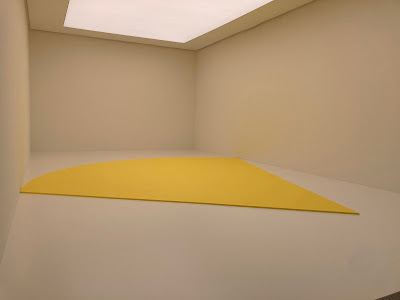 |
| Chiharu Shiota, Uncertain Journey, 2016/2024 |
Chiharu Shiota's exhibition at the Grand Palais is magesterial. Visitors enter into a haunted space filled with frames of steel boats, and Shiota's signature red yarn creating complex webs of bleeding life in Uncertain Journey (2016/2024). On many levels the weave of red yarn is mesmerizing: most immediately, visitors will be amazed at the amount of work in the sculptures - clearly, the installation is time and energy consuming to put together with threads woven, tied, knotted, strung and entwined to fill the entire room. The threads create a dense, cloud of red, woven together, clinging to walls, sprouting up and around the space. It is as if the web is still in process, still growing, the traces of a creature who continues to work, invisible. For Shiota, the threads are evidence of her existence, her weaving of ideas, of relationships, of memories of the spaces she has traversed. Thus, for Shiota, that creature fabricating this web is us humans, and the work represents the "uncertain journey" of life as we sail around the spaces of our existence. The skeletal boat hulls, as if burnt remnants of some kind of apocalypse, appear to sprout the red woven yarn, like clouds of vapour filling the ten foot high space. At the same time, it is as if they threads are being guided by the boat hulls, pulled on their way to another land.
 |
| Chiharu Shiota, Inside-Outside, 2008-2024 |
The marriage of opposites—objects and installations that can be seen as depictions of creativity and destruction, life and death, possibility and entrapment—is the signature concern of Shiota's work. In Inside-Outside, for example, window frames collected from construction sites for the rebuilding of former East Berlin in the early 2000s, climb skyward, one on top of the other, sometimes doubled by more windows, into a wall that separates inside from outside. It's impossible to know if one is on the inside or the outside of this wall of windows, what is excluded, what is contained, where one is standing. And even though we are walled in by windows, we know there is an other side. We cannot always see through the windows, or if we do, the image on the other side is blurred, or fragmented so that looking at the window becomes more satisfying than what is on the other side. Such was life in the former East Berlin. Some of the windows are broken, some frames have no windows at all, others are boarded up, the function of what we know as a window has become a thing of the past. None of the windows are open, all are old, deteriorated, more objects to look at than gateways to another world. And so, Shiota transforms the meaning of what we know a window to be.
 |
| Chiharu Shiota, In Silence, 2004 |
Thanks to Shiota's residence in Germany, it's difficult not to think of the Holocaust when wandering through the exhibition. Particularly because she uses the objects that are often found in Holocaust art representations. Old shoes and clothes are scattered throughout the exhibition spaces. And inside (or outside) the windows of Inside—Outside we are reminded of all those windows that don't open. The windows of Auschwitz block 8 that were permanently shuttered in order that the occupants would not see the killings taking place on the other side. Or those windows with their recognizeable frames on the barracks at Auschwitz, rendering life opaque and inevitable for their occupants.
 |
| Chiharu Shiota, Accumulation - Searching for the Destination, 2014/2024 |
In perhaps the most imposing, yet precarious of the eight installations that comprise The Soul Trembles Accumulation - Searching for the Destination sees Shiota put another symbol of the Holocaust to unique use. Old suitcases are suspended form red cords, cluttered together, slowly rising to the heavens. The stairway to heaven is said to be holding memories, experiences, but given their prominence in Holocaust art, we look at Shiota's suitcases and see the dispossessed. The suitcase is not only for those who move around by choice, but those whose lives have been confiscated, their destiny in a suitcase removed forever. I think of how much is held within the suitcase. When we travel, we are separated from our suitcases, they contain everything we need for the time that we are away from home, and yet, we willingly let go of them as we step on a plane. The suitcase, like old shoes, clothes, a burnt out piano, chairs without seats is, all at once, about motion and possiblity of what lies ahead, about new horizons. And in its association with the Holocaust, it is also about death, stagnation, stasis.
 |
| Chiharu Shiota, Accumulation - Searching for the Destination, 2014/2024 |
Depending on which end we begin our exploration of Accumulation, the suitcases might also be a stairway from heaven to ground, gravity pulling us to a firm place, our own place on earth, thus, fixity. The suitcase comes with us from one world to the next, it is a vessel for all that we want to do in the future, and simultaneously, a memory of the past. For Shiota, the past and future are connected, unsurprisingly, with red thread, the blood running through one generation to the next.


































